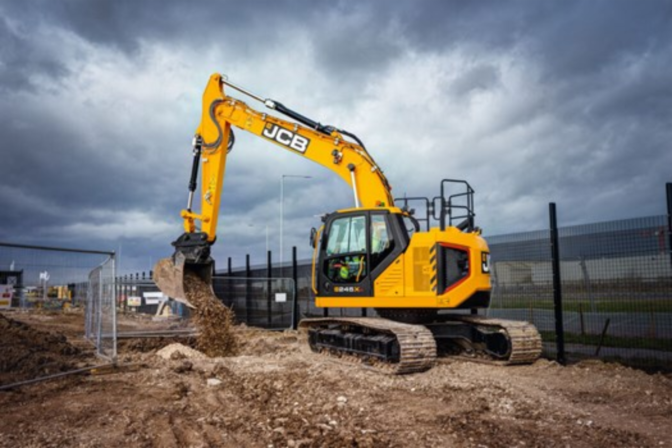What Is a Wheel Loader?
A wheel loader is a heavy-duty construction machine equipped with large wheels and a wide front bucket. It is designed to move large quantities of materials like dirt, gravel, sand, and rocks. Unlike track loaders, wheel loaders are faster, more maneuverable, and versatile, making them ideal for a wide range of tasks.


Key Features of Wheel Loaders
- Powerful Engine:
- Wheel loaders are powered by strong engines capable of handling heavy loads and working in demanding environments
Articulated Steering:
- The flexible articulated steering system allows for sharp turns and easy maneuverability in tight spaces, which is especially useful on construction sites or uneven terrain.
Large Bucket:
- The front bucket is the main tool for lifting and transporting materials. It can vary in size depending on the model, making it suitable for both light and heavy-duty tasks.
Hydraulic System:
- A robust hydraulic system ensures smooth lifting, lowering, and dumping of materials, allowing operators to work quickly and efficiently.
All-Terrain Capabilities:
- With large wheels and durable construction, wheel loaders can operate on rough, uneven, or soft surfaces without losing stability.
Common Uses of Wheel Loaders
Wheel loaders are versatile machines and can be used in a variety of industries and applications. Some of their most common uses include:
- Construction:
- Moving soil, gravel, sand, and other materials around job sites.
- Loading trucks with materials for transport.
- Agriculture:
- Handling feed, manure, and other agricultural products.
- Clearing land or preparing fields for planting.
- Mining and Quarrying:
- Lifting and transporting mined materials like rocks and minerals.
- Landscaping:
- Removing debris, grading land, and preparing large areas for landscaping projects.
- Municipal Work:
- Cleaning streets, snow removal, and clearing debris after storms.
Types of Wheel Loaders
There are several types of wheel loaders, each designed for specific tasks. Here’s a breakdown of the most common types:
- Compact Wheel Loaders:
- Smaller in size, these loaders are perfect for tasks in confined spaces such as urban construction sites or farms. They are more fuel-efficient and easier to transport than larger models.
- Mid-Sized Wheel Loaders:
- These loaders offer a balance between power and versatility. They are often used in construction, mining, and material handling operations.
- Large Wheel Loaders:
- Designed for heavy-duty work, large wheel loaders are equipped with powerful engines and extra-large buckets. They are ideal for mining, large-scale construction projects, and other heavy material handling tasks.
Benefits of Using Wheel Loaders
- Efficiency:
- Wheel loaders allow for quick and easy movement of large amounts of material, speeding up tasks and improving overall productivity on job sites.
- Versatility:
- With the ability to switch attachments (such as forks, blades, or grapples), wheel loaders can perform various tasks beyond just loading, including lifting, digging, and grading.
- Durability:
- Built to handle heavy loads and tough environments, wheel loaders are designed to last and require minimal maintenance if properly used.
- Maneuverability:
- Thanks to their articulated steering and all-terrain capabilities, wheel loaders can navigate tight spaces and rough ground more effectively than other types of loaders.
- Operator Comfort:
- Modern wheel loaders are equipped with comfortable, air-conditioned cabins and user-friendly controls, ensuring that operators can work efficiently over long hours.
How to Choose the Right Wheel Loader
When selecting a wheel loader for your business, consider the following factors:
- Size and Load Capacity:
- Choose a wheel loader with a bucket size and weight capacity that meets the requirements of your specific job. Larger machines are better for heavy-duty tasks, while compact models may be better suited for smaller, more agile operations.
- Attachments:
- Consider what attachments you’ll need to maximize the versatility of the loader. Buckets, grapples, forks, and snow blades are some of the most common attachments used with wheel loaders.
- Terrain and Job Site Conditions:
- Assess the ground conditions at your job site. If the terrain is uneven or soft, opt for a wheel loader that is equipped with large, durable tires and high ground clearance.
- Fuel Efficiency:
- Look for models with fuel-efficient engines to reduce operational costs, especially if the machine will be used for extended periods.
- Operator Comfort:
- Ensure the cab has comfortable seating, air conditioning, and easy-to-use controls to keep the operator comfortable and productive throughout the day.
Maintaining Your Wheel Loader
To ensure the longevity of your wheel loader and keep it running at peak efficiency, regular maintenance is crucial. Here are some maintenance tips:
- Daily Inspections:
- Check fluid levels (engine oil, hydraulic fluid) and inspect tires, hoses, and attachments for wear and tear.
- Clean the Machine:
- Keep the loader clean from dirt, debris, and other materials that can clog moving parts or damage the hydraulic system.
- Lubrication:
- Regularly lubricate all moving parts and hinges to reduce friction and prevent breakdowns.
- Tire Pressure:
- Check tire pressure regularly to avoid uneven wear and ensure stability on all terrains.
- Scheduled Servicing:
- Follow the manufacturer’s service schedule to replace filters, fluids, and worn parts on time.




